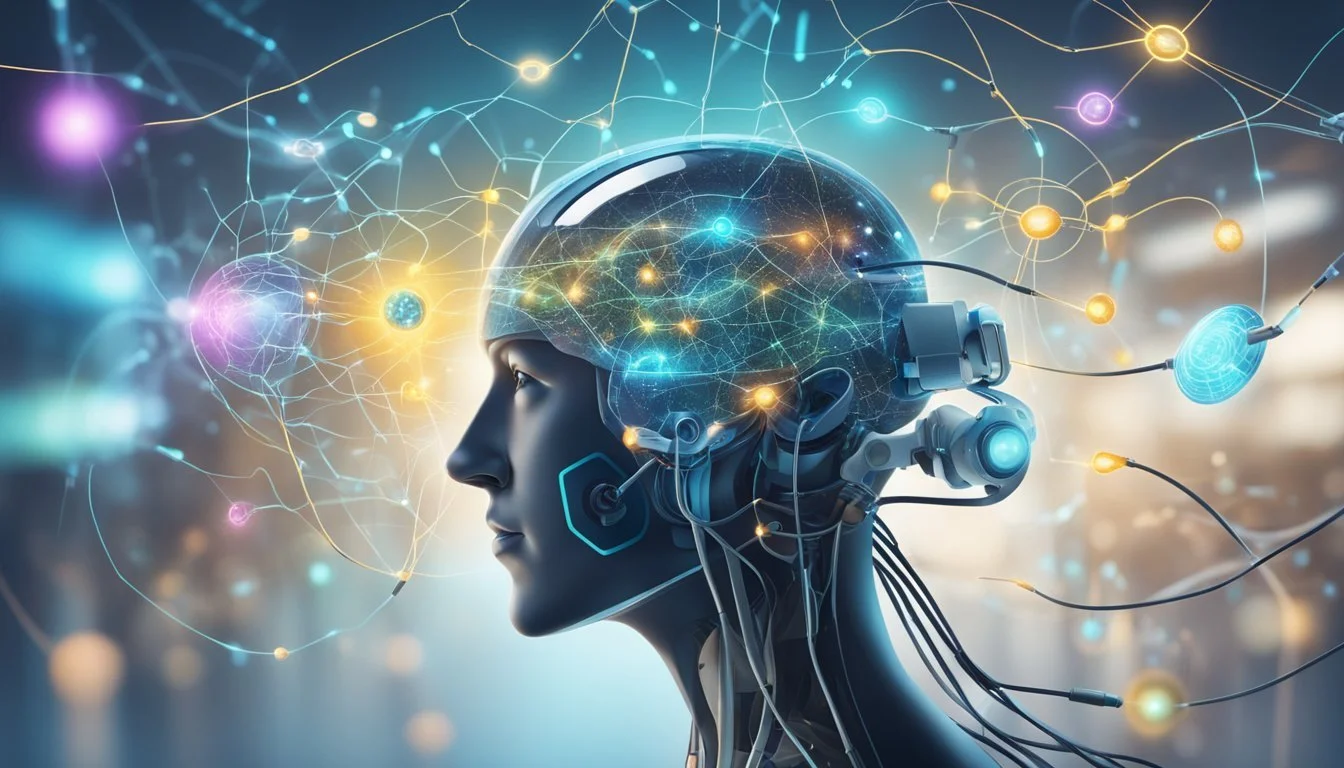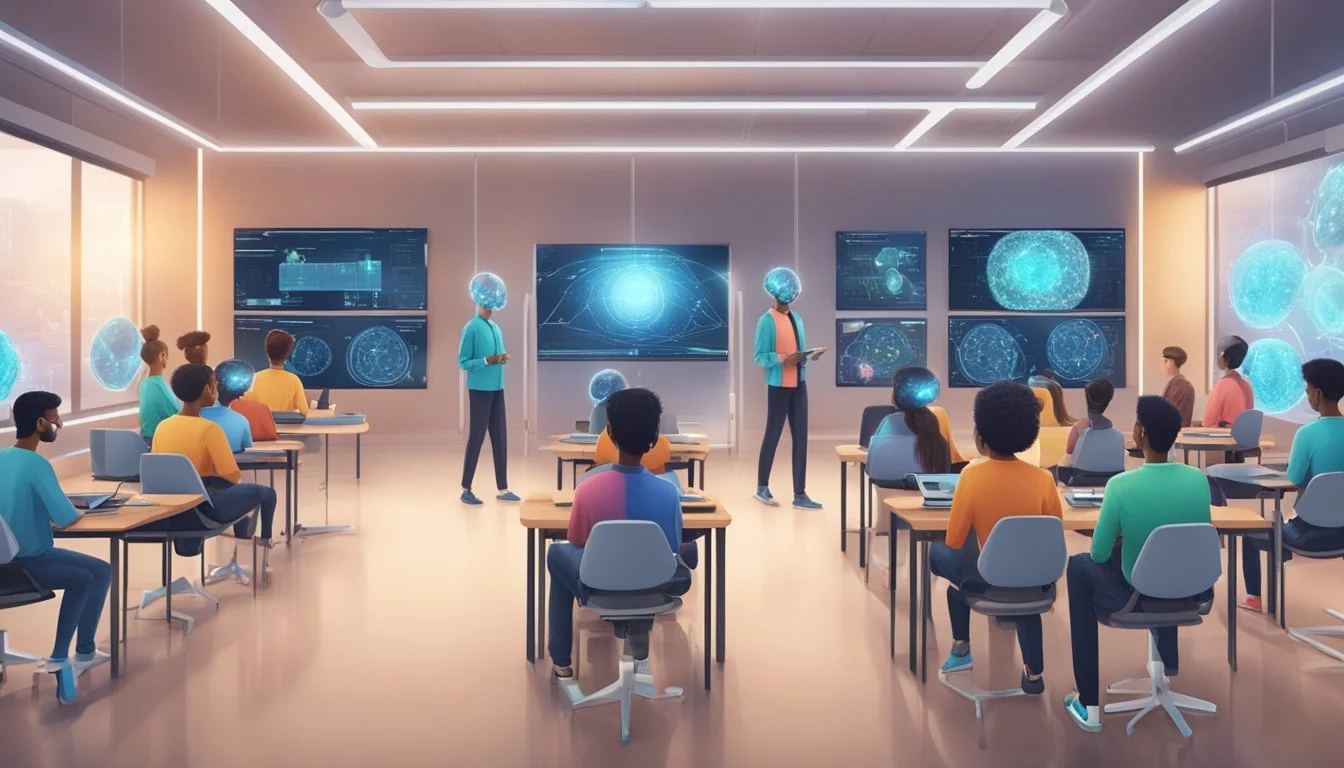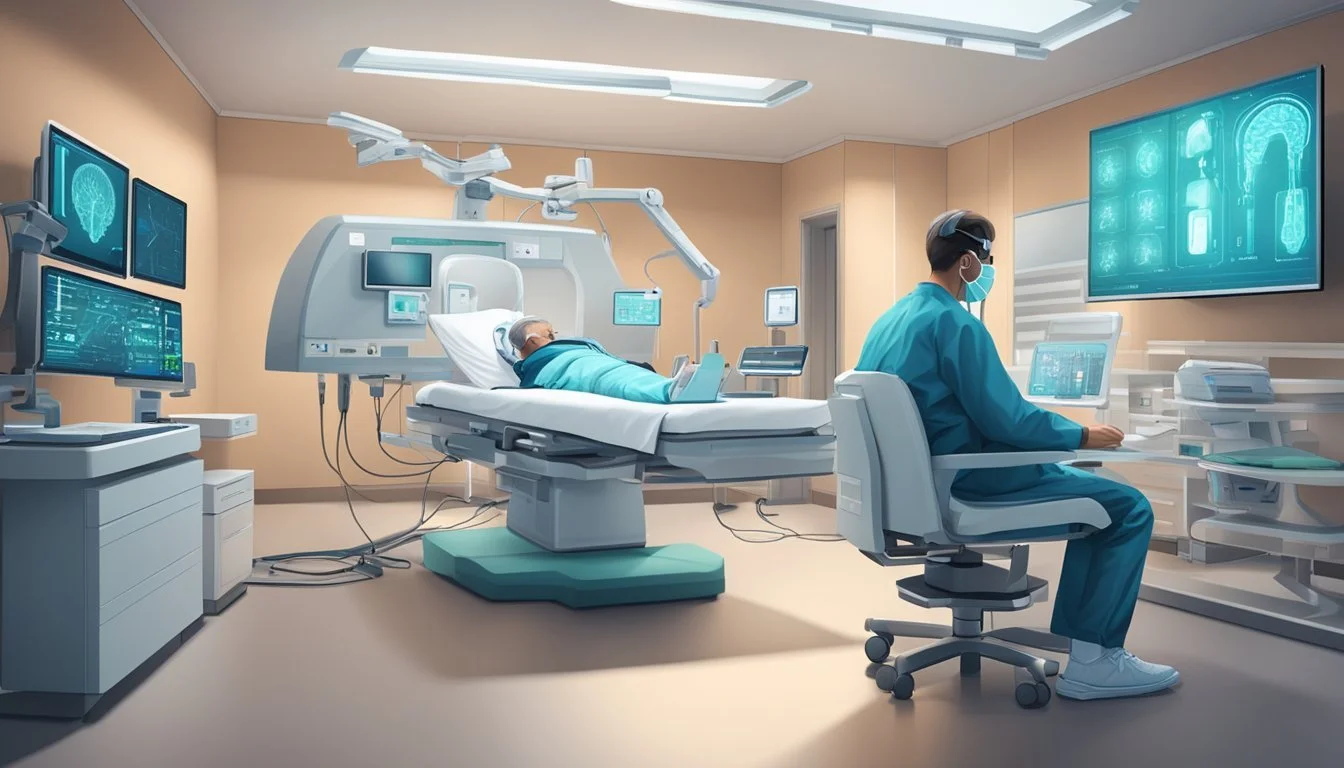Mind-Meld Shockwaves
7 Industries Neuralink May Upend
Neuralink, Elon Musk's brain-computer interface company, aims to revolutionize how humans interact with technology. By developing implantable brain-machine interfaces, Neuralink has the potential to transform various industries beyond its primary focus on medical applications.
Neuralink's technology could disrupt multiple sectors by enhancing human capabilities and changing how we process information and interact with our environment. From healthcare to communication, education to entertainment, the ripple effects of brain-computer interfaces may reshape entire industries and create new opportunities for innovation and growth.
1) Healthcare Devices
Neuralink's brain-computer interface technology could revolutionize healthcare devices. The company's experimental implants aim to restore vision, as evidenced by their "Blindsight" project receiving FDA breakthrough device designation.
This advancement opens doors for treating various neurological conditions. Patients with visual impairments may benefit from Neuralink's efforts to create artificial vision through brain implants.
Beyond vision, Neuralink's technology could impact other sensory restoration devices. It may lead to innovative solutions for hearing loss, speech impediments, and motor control issues.
The potential for real-time health monitoring is another area where Neuralink could disrupt traditional healthcare devices. Brain-computer interfaces might allow for continuous tracking of vital signs and neurological functions.
Neuralink's technology could also enhance prosthetics and assistive devices. By directly interfacing with the brain, these devices may offer more intuitive control and improved functionality for users.
As Neuralink progresses, it may challenge established medical device manufacturers. The company's innovative approach could lead to new standards in neurological treatments and rehabilitation technologies.
2) Mental Health Therapies
Neuralink's brain-computer interface technology could revolutionize mental health treatments. The device may offer precise, targeted interventions for conditions like depression, anxiety, and PTSD.
By directly interacting with neural circuits, Neuralink could potentially modulate brain activity associated with mental health disorders. This approach may provide more effective and personalized treatments compared to traditional medications or therapies.
The technology could enable real-time monitoring of brain states, allowing for early detection and intervention in mental health crises. It may also facilitate more accurate diagnoses by providing detailed data on brain function.
Neuralink's device could enhance cognitive behavioral therapies by providing immediate feedback on thought patterns and emotional responses. This could help patients develop more effective coping strategies and break negative thought cycles.
The technology may also open new avenues for treating conditions that have been resistant to conventional therapies. By directly targeting specific brain regions, it could offer hope to patients who have not responded to other treatments.
As with any emerging technology, ethical considerations and rigorous testing will be crucial before widespread adoption in mental health care.
3) Assistive Robotics
Neuralink's brain-computer interface technology could revolutionize the field of assistive robotics. By enabling direct communication between the human brain and robotic devices, individuals with physical disabilities may gain unprecedented control over prosthetic limbs and exoskeletons.
The Telepathy implant, designed to help those with severe physical disabilities control digital devices through thought, could be adapted for robotic systems. This advancement would allow for more intuitive and responsive control of assistive devices.
Paralyzed individuals might regain mobility through brain-controlled robotic limbs or full-body exoskeletons. The high-resolution neural interface could provide finer motor control and sensory feedback, making the use of assistive robots feel more natural.
Neuralink's technology could also enhance the capabilities of existing assistive robots. These devices could become more responsive to users' intentions, potentially reducing the learning curve and improving overall usability.
As the technology progresses, assistive robots might evolve from external devices to fully integrated extensions of the human body. This integration could blur the lines between biological and artificial limbs, offering new possibilities for those with physical disabilities.
4) Educational Tools
Neuralink's brain-computer interface technology could revolutionize the education sector. The potential for direct brain-to-machine communication opens up new possibilities for learning and information retention.
Students might be able to absorb information at unprecedented speeds, potentially reducing years of study to mere months or even weeks. This could lead to more efficient and personalized learning experiences tailored to individual cognitive patterns.
The technology may also assist those with learning disabilities by providing alternative pathways for information processing. It could help level the educational playing field, allowing more people to access and benefit from advanced learning opportunities.
Educational institutions may need to adapt their curricula and teaching methods to accommodate these technological advancements. Traditional classroom settings could evolve into more interactive and immersive learning environments.
The integration of Neuralink technology in education raises questions about the nature of knowledge acquisition and the value of traditional learning methods. It may prompt a reevaluation of educational standards and assessment techniques.
5) Remote Work Technologies
Neuralink's brain-computer interface technology could revolutionize remote work. The ability to directly interface with computers and digital systems through thought could enhance productivity and collaboration for remote workers.
Virtual meetings could become more immersive and interactive. Participants might share ideas and visualizations directly from their minds, creating a more engaging experience than current video conferencing tools.
Data input and analysis could be streamlined. Workers could potentially process information faster and more accurately by interfacing directly with databases and software through neural connections.
Creative professionals might benefit from the ability to translate mental concepts directly into digital designs or content. This could speed up ideation and production processes for remote teams.
Language barriers in global remote work could be reduced. Neural interfaces may facilitate real-time translation, allowing seamless communication between team members speaking different languages.
While these possibilities are intriguing, practical implementation of Neuralink technology in remote work settings remains speculative. Ethical considerations and technological hurdles must be addressed before such applications become reality.
6) Entertainment Platforms
Neuralink's brain-computer interface technology could revolutionize how people interact with entertainment platforms. Direct neural connections may enable users to control streaming services, video games, and other media with their thoughts alone.
This could lead to more immersive and responsive entertainment experiences. For example, viewers might be able to influence the storylines of interactive shows in real-time simply by thinking about their desired outcomes.
Gaming could see a significant transformation. Players may be able to control in-game characters and actions through neural signals, potentially increasing gameplay speed and precision beyond what's possible with traditional controllers.
Music streaming services could leverage Neuralink to curate playlists based on a user's emotional state or subconscious preferences. This may result in highly personalized listening experiences that adapt in real-time to the user's mood and thoughts.
Virtual and augmented reality platforms might also integrate Neuralink technology. This could create more realistic and engaging virtual environments by translating neural signals into actions within the digital space.
As entertainment becomes more closely linked to neural activity, concerns about privacy and data security may arise. Platforms will need to address these issues to gain consumer trust and adoption.
7) Communication Enhancements
Neuralink's brain-computer interface technology has the potential to revolutionize communication. The device could enable direct brain-to-brain communication, allowing thoughts to be transmitted without the need for speech or text.
This advancement may transform how people interact, especially for those with communication disorders or disabilities. Individuals who have lost the ability to speak could regain a voice through neural signals.
The technology might also facilitate rapid information exchange, surpassing the speed of conventional communication methods. Complex ideas and emotions could be shared instantly and accurately.
Language barriers could become obsolete as neural interfaces translate thoughts across different languages in real-time. This would streamline international business, diplomacy, and cultural exchange.
The communication industry may need to adapt to this new paradigm. Traditional telecommunication companies and social media platforms might integrate neural interface capabilities into their services.
Privacy and security concerns will likely arise as thoughts become transmittable data. New regulations and ethical guidelines may be necessary to protect individuals' mental privacy and prevent unauthorized access to neural communications.
Impact on Healthcare
Neuralink's brain-computer interface technology has the potential to revolutionize healthcare, particularly in areas related to neurological conditions and disabilities. The company's innovations could lead to significant advancements in patient care and treatment options.
Advancements in Neuroprosthetics
Neuralink's brain implants may greatly enhance neuroprosthetic capabilities. These devices could allow individuals with paralysis or limb loss to control robotic limbs with their thoughts, restoring mobility and independence. The technology might also improve communication for people with speech impairments by translating brain signals into spoken words or text.
Sensory feedback is another area where Neuralink could make strides. By stimulating specific brain regions, the implants may restore sensations of touch, pressure, and temperature to prosthetic limbs, creating a more natural and intuitive user experience.
Potential for Neurological Disorder Treatment
Neuralink's technology holds promise for treating various neurological disorders. The implants could potentially alleviate symptoms of Parkinson's disease by delivering targeted electrical stimulation to affected brain areas, reducing tremors and improving motor function.
For epilepsy patients, the devices might detect and prevent seizures before they occur. In cases of severe depression or obsessive-compulsive disorder, brain-computer interfaces could offer new therapeutic approaches by modulating neural activity in specific regions.
Alzheimer's disease and other forms of dementia might also benefit from Neuralink's innovations. The implants could potentially assist with memory recall or slow cognitive decline by stimulating key brain areas involved in memory formation and retention.
Transformation of Communication
Neuralink's brain-computer interface technology has the potential to revolutionize how humans communicate. This emerging field could enable direct brain-to-brain interactions and dramatically enhance our ability to interface with computers and digital systems.
Brain-to-Brain Communication
Neuralink's neural implants may eventually allow individuals to transmit thoughts, emotions, and sensory experiences directly to each other's minds. This could enable near-instantaneous sharing of complex ideas and feelings without the limitations of verbal or written language.
Early experiments have already demonstrated rudimentary brain-to-brain communication in laboratory settings. As the technology advances, it may become possible to engage in silent conversations or share vivid mental imagery across vast distances.
This direct neural link could transform personal relationships, business collaborations, and creative partnerships. It may also raise new questions about privacy and the boundaries between individual minds.
Enhancing Human-Computer Interaction
Neuralink's brain-computer interfaces promise to create seamless connections between human cognition and digital systems. Users may gain the ability to control computers, smartphones, and other devices through thought alone.
This could enable faster, more intuitive interactions with technology. Tasks like typing, web browsing, and digital design could be accomplished through mental commands rather than physical inputs.
For individuals with physical disabilities, neural interfaces may provide new avenues for communication and control of assistive technologies. This could significantly improve quality of life and independence for many people.
As these systems evolve, they may blur the line between biological and artificial intelligence, potentially leading to new forms of cognitive augmentation and human-AI collaboration.










